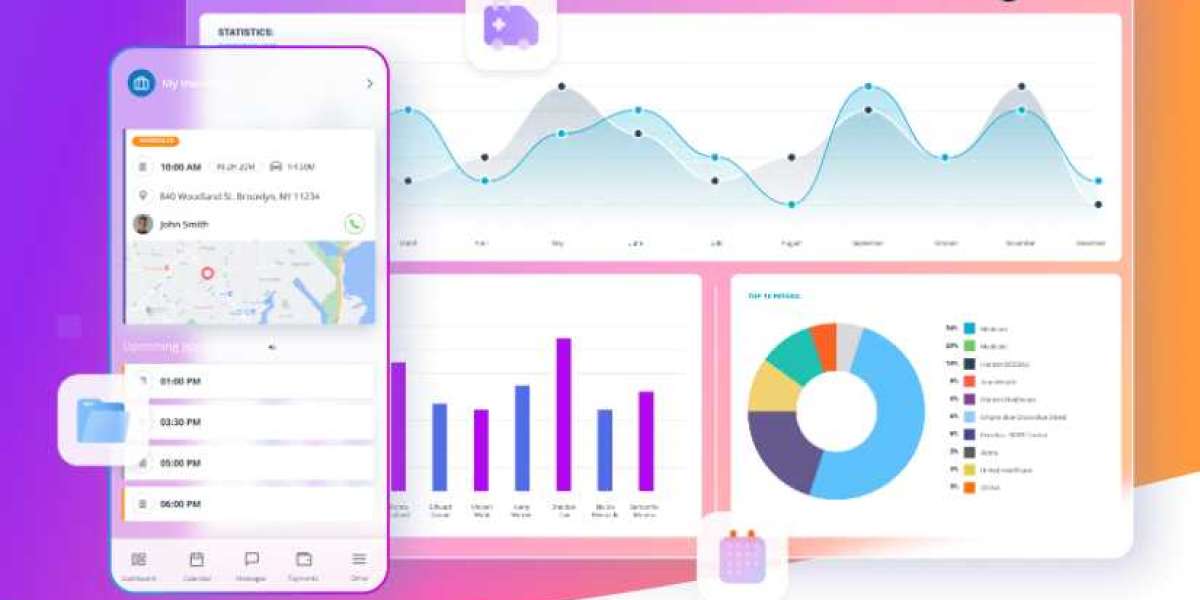Introduction
In an era where healthcare innovation is advancing at breakneck speed, managing medical equipment efficiently has become a critical component of successful healthcare delivery. Medical Equipment Management Software (MEMS) is at the forefront of this transformation, providing healthcare facilities with powerful tools to oversee their medical assets. This comprehensive guide explores the features, benefits, and future trends of MEMS, offering insights into how this technology is revolutionizing equipment management in healthcare settings.
What is Medical Equipment Management Software?
Medical Equipment Management Software is a sophisticated digital solution designed to manage the lifecycle of medical devices within healthcare facilities. From acquisition and deployment to maintenance and disposal, MEMS provides a centralized platform for tracking and managing medical equipment. This software is crucial for ensuring operational efficiency, compliance with regulations, and optimal patient care.
Core Features of Medical Equipment Management Software
1. Asset Tracking and Inventory Management
One of the fundamental features of MEMS is asset tracking. This functionality allows healthcare facilities to maintain a comprehensive inventory of medical equipment. Key aspects include:
- Real-Time Tracking: MEMS offers real-time visibility into the location and status of medical devices. This is achieved through barcode scanning, RFID tags, or GPS tracking, enabling facilities to monitor equipment movement and usage.
- Detailed Records: The software maintains detailed records of each device, including serial numbers, purchase dates, warranty information, and service history. This information is crucial for effective asset management and decision-making.
2. Maintenance Scheduling and Management
Regular maintenance is essential for ensuring the reliability and safety of medical equipment. MEMS facilitates:
- Automated Scheduling: The software automates maintenance schedules, generating reminders and alerts for routine checks, preventive maintenance, and calibration. This helps ensure that maintenance tasks are completed on time, reducing the risk of equipment failure.
- Maintenance History: MEMS tracks all maintenance activities, providing a comprehensive history of inspections, repairs, and servicing. This history is valuable for identifying trends and planning future maintenance.
3. Regulatory Compliance
Compliance with industry regulations is critical in healthcare. MEMS supports regulatory adherence by:
- Tracking Compliance Activities: The software monitors compliance with standards set by regulatory bodies such as the FDA, ISO, and other relevant organizations. It keeps records of inspections, certifications, and audits.
- Generating Reports: MEMS can generate reports that document compliance activities, facilitating audits and inspections. These reports help ensure that facilities meet regulatory requirements and avoid potential penalties.
4. Usage Monitoring and Analytics
Understanding equipment usage patterns is essential for optimizing asset management. MEMS provides:
- Usage Data: The software tracks how frequently and extensively each device is used. This data helps identify high-demand equipment and potential underutilization.
- Analytics and Insights: MEMS analyzes usage data to provide insights into equipment performance and utilization trends. This information supports decision-making regarding equipment procurement, replacement, and optimization.
5. Inventory Optimization
Effective inventory management is crucial for minimizing costs and ensuring equipment availability. MEMS helps with:
- Inventory Control: The software tracks inventory levels, helping facilities avoid overstocking or understocking. It provides insights into inventory turnover rates and usage patterns.
- Demand Forecasting: MEMS can forecast future equipment needs based on historical data and usage trends. This forecasting enables better planning and resource allocation.
6. Integration with Other Healthcare Systems
Modern MEMS solutions often integrate with other healthcare management systems, such as:
- Electronic Health Records (EHRs): Integration with EHR systems ensures seamless data flow between patient records and equipment management. This integration enhances the accuracy of equipment-related documentation.
- Hospital Information Systems (HIS): Integration with HIS provides a unified view of hospital operations, including equipment management. This integration improves coordination and efficiency across different departments.
7. Reporting and Data Analytics
MEMS generates detailed reports and analytics, including:
- Performance Reports: The software provides reports on equipment performance, maintenance history, and usage statistics. These reports help identify areas for improvement and track key performance indicators (KPIs).
- Financial Reports: MEMS generates financial reports on equipment costs, maintenance expenses, and overall asset value. These reports assist in budget planning and cost management.
8. User-Friendly Interface
A user-friendly interface is essential for ensuring effective use of MEMS. Key aspects include:
- Intuitive Design: The software should offer an intuitive design that simplifies navigation and data entry. This design helps users quickly access the information they need.
- Customizable Dashboards: MEMS often includes customizable dashboards that allow users to tailor their views based on their specific needs and roles within the facility.
Benefits of Medical Equipment Management Software
1. Enhanced Operational Efficiency
MEMS streamlines various aspects of equipment management, leading to:
- Reduced Administrative Burden: By automating tasks such as scheduling, tracking, and reporting, MEMS reduces the administrative workload on staff. This allows healthcare providers to focus more on patient care.
- Improved Workflow: The software enhances workflow efficiency by providing real-time visibility into equipment status and location. This improves coordination and reduces downtime.
2. Cost Savings
Effective equipment management leads to significant cost savings:
- Optimized Inventory: MEMS helps prevent overstocking and understocking, reducing inventory holding costs. It also identifies opportunities for cost-effective equipment procurement and replacement.
- Reduced Maintenance Costs: Timely maintenance and calibration facilitated by MEMS minimize the risk of costly equipment failures and extend the lifespan of devices.
3. Improved Patient Safety
Patient safety is a top priority in healthcare:
- Reliable Equipment: MEMS ensures that equipment is regularly maintained and calibrated, reducing the risk of malfunction. This contributes to safer patient care and better clinical outcomes.
- Compliance with Standards: By tracking compliance with regulatory standards, MEMS helps maintain high safety and quality standards.
4. Data-Driven Decision Making
Access to comprehensive data enables informed decision-making:
- Informed Procurement: MEMS provides insights into equipment usage and performance, supporting strategic decisions about procurement and replacement.
- Strategic Planning: The data generated by MEMS assists in long-term planning and resource allocation, helping facilities align their equipment management strategies with overall organizational goals.
5. Reduced Equipment Downtime
MEMS helps minimize equipment downtime:
- Proactive Maintenance: Automated maintenance scheduling and alerts ensure that equipment is serviced before issues arise. This reduces the likelihood of unexpected breakdowns.
- Efficient Troubleshooting: The software provides detailed maintenance histories and usage data, aiding in quick and accurate troubleshooting.
6. Increased Accountability
MEMS fosters accountability among staff:
- Transparent Records: The software maintains clear records of equipment management activities, including maintenance, usage, and compliance. This transparency promotes accountability and ensures tasks are completed as required.
- Performance Tracking: MEMS tracks staff performance related to equipment management, helping identify areas for improvement and recognizing achievements.
Implementing Medical Equipment Management Software
1. Assessing Needs and Requirements
Before selecting MEMS, healthcare facilities should:
- Evaluate Requirements: Assess the specific needs of the facility, including the types of equipment to be managed, the scale of operations, and regulatory requirements.
- Identify Objectives: Define clear objectives for implementing MEMS, such as improving efficiency, reducing costs, or enhancing compliance.
2. Selecting the Right Software
Choosing the right MEMS involves:
- Comparing Options: Evaluate different software solutions based on functionality, ease of use, integration capabilities, and cost. Request demonstrations and seek feedback from current users.
- Considering Scalability: Ensure that the software can scale to accommodate future growth and changes in the facility's needs.
3. Data Migration and Integration
Implementing MEMS requires:
- Data Migration: Transfer existing equipment data into the new system. This involves data cleansing, mapping, and validation to ensure accuracy.
- System Integration: Integrate MEMS with other healthcare management systems, such as EHRs and HIS, to ensure seamless data flow and coordination.
4. Training and Onboarding
Proper training is essential:
- User Training: Provide comprehensive training for staff on using MEMS, including its features and functionalities. Ensure that users understand how to perform their tasks efficiently.
- Ongoing Support: Offer ongoing support and resources to address any issues or questions that arise during and after implementation.
5. Monitoring and Evaluation
Continuously monitor and evaluate:
- Performance Review: Regularly review the performance of MEMS, including system reports, user feedback, and key metrics. Identify areas for improvement and make necessary adjustments.
- User Feedback: Gather feedback from users to assess their experience with the software and identify opportunities for enhancement.
6. Ongoing Support and Maintenance
Ensure that the software remains effective:
- Support Plan: Establish a support plan with the software provider to address any issues, updates, or enhancements. Ensure that the provider offers reliable support and timely responses.
- Regular Updates: Keep the software up-to-date with the latest features and security patches to maintain its effectiveness and compliance with industry standards.
Future Trends in Medical Equipment Management Software
1. Integration with IoT and Smart Devices
The integration of MEMS with Internet of Things (IoT) and smart devices is transforming equipment management:
- Real-Time Data: IoT-enabled devices provide real-time data on equipment performance, usage, and maintenance needs. This integration enhances the capabilities of MEMS, enabling proactive management and data-driven decision-making.
- Remote Monitoring: IoT integration allows for remote monitoring and management of medical equipment, improving efficiency and reducing the need for on-site interventions.
2. Advanced Data Analytics and AI
The use of advanced data analytics and artificial intelligence (AI) in MEMS is set to revolutionize equipment management:
- Predictive Maintenance: AI algorithms can analyze large volumes of data to predict equipment failures and optimize maintenance schedules. This predictive capability reduces downtime and maintenance costs.
- Enhanced Decision-Making: Advanced analytics provide deeper insights into equipment performance and usage, supporting more informed decision-making and strategic planning.
3. Cloud-Based Solutions
Cloud-based MEMS solutions offer numerous advantages:
- Scalability: Cloud platforms provide scalable solutions that can grow with the facility's needs. They offer flexibility in managing equipment data and resources.
- Remote Access: Cloud-based solutions enable remote access to equipment management tools, allowing staff to monitor and manage equipment from anywhere.
4. Mobile-Friendly Solutions
Mobile-friendly MEMS solutions enhance accessibility:
- Mobile Apps: Mobile applications allow users to access equipment management tools and data on their smartphones and tablets. This improves flexibility and responsiveness.
- Responsive Design: MEMS with responsive design ensures that the software functions seamlessly across various devices, enhancing usability and user experience.
5. Integration with Telemedicine
The rise of telemedicine presents opportunities for MEMS integration:
- Remote Equipment Management: Integration with telehealth platforms facilitates remote management of equipment used in virtual care and remote patient monitoring.
- Enhanced Coordination: Seamless integration ensures that equipment used in telemedicine is effectively managed, supporting high-quality virtual care.
6. Personalized User Experience
Future MEMS solutions will offer more personalized user experiences:
- Customizable Dashboards: Users will have the ability to customize their dashboards based on their roles and preferences, improving usability and efficiency.
- Tailored Notifications: Personalized notifications and alerts will ensure that users receive relevant information based on their specific needs and responsibilities.
7. Focus on Sustainability
Sustainability will become a key focus for MEMS:
- Eco-Friendly Practices: MEMS solutions will support eco-friendly practices, such as reducing equipment waste and optimizing resource usage.
- Green Initiatives: The software will align with the facility's sustainability goals, contributing to overall environmental objectives.
Conclusion
Medical Equipment Management Software is a vital tool for modern healthcare facilities, offering a range of features and benefits that enhance operational efficiency, cost management, and patient safety. By providing real-time tracking, maintenance management, regulatory compliance, and data analytics, MEMS transforms the way medical equipment is managed.
As technology continues to evolve, future trends such as IoT integration, AI, cloud-based solutions, and mobile-friendly designs will further enhance the capabilities of MEMS. Embracing these innovations will enable healthcare facilities to stay ahead of the curve, optimize their equipment management practices, and deliver exceptional care to their patients.
In a rapidly changing healthcare environment, investing in advanced medical equipment management software is not just a necessity but a strategic advantage. By leveraging the power of MEMS, healthcare organizations can achieve greater efficiency, cost savings, and improved patient outcomes, ultimately contributing to the advancement of healthcare delivery.






